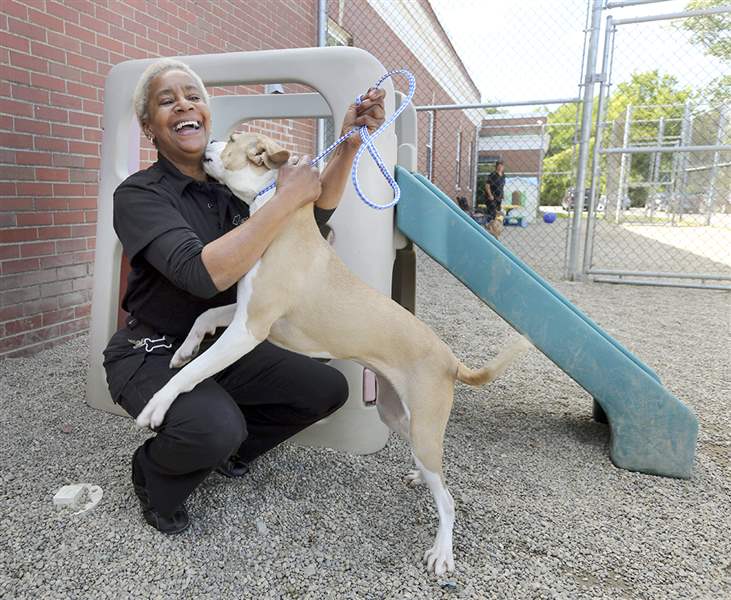
County says more dogs at shelter saved
Adoptions through partners credited for improving rate
9/20/2014
Employee Shirley Wheeler plays with Taylor at Lucas County Canine Care & Control.
THE BLADE/JEREMY WADSWORTH
Buy This Image

Lyle
Area animal rescues are seeing an uptick in the number of animals saved, including dogs, at the once beleaguered Lucas County Canine Care & Control.
As five rescue groups geared up for a superhero-themed mega adoption event today and Sunday at the Lucas County Recreation Center in Maumee, the county shelter is already celebrating a record-high save rate for the dogs there.
The shelter has adopted out, transferred to rescue, or returned to owners 1,482 of the 2,402 dogs brought to the shelter this year through Aug. 31, a total of 61.7 percent.
“It’s been hovering around there for the last few months,” Director Julie Lyle said.
The Blade’s calculations differ slightly from the county shelter’s because the shelter does not include dogs killed at their owners’ request in the total intake number when calculating a save rate.
The shelter’s records before 2010 did not make that distinction and could not be recalculated, so The Blade used the older formula to ensure comparable data.
In 2008, the last full year under former dog warden Tom Skeldon’s administration, the shelter saved 1,042 of 3,774 dogs, or 27.6 percent. The rate has climbed regularly since.
“We’ve come a long way,” Ms. Lyle said. “It’s a combination of everything we’re doing.”

Employee Shirley Wheeler plays with Taylor at Lucas County Canine Care & Control.
Ms. Lyle noted longer shelter hours and more space for adoptable dogs, adoption events and specials, increased capability and donated funds for medical care, the shelter’s volunteer program, stronger public presence through outreach programs, and social media as factors contributing to the higher save rate.
But one of the biggest factors is the shelter’s network of about 60 transfer partners, including a large number of breed-specific rescues. Several of the core group of local transfer partners have experienced an increase in adoptions that, in turn, open up space to pull more dogs from the county shelter.
“Shelters around the country are doing better jobs of pooling their resources,” said Gary Willoughby, executive director of the Toledo Area Humane Society. “We’re all working together more, in the same direction, and that saves more animals.”
The Humane Society is the county shelter’s largest transfer partner, having pulled 319 dogs through Aug. 31 this year. The Humane Society adopted out 1,000 canines through August this year, compared with 894 during the same period in 2013, which opened up more space this year for transfers.
“We do get animals from a number of shelters, but our No. 1 priority has always been Lucas County,” Mr. Willoughby said. “We take what we can from them before going elsewhere. That’s what we’ll continue to do.”

Planned Pethood, which has pulled 108 dogs from the county shelter as of Sept. 8, has more adoptions with 374 canines in new homes so far in 2014, compared with 239 by this time last year.
Executive Director Nikki Morey said rescues could be beginning to see a cultural shift toward adoption of animals versus purchasing them from breeders or stores.
“There is a better understanding of the importance of rescuing as opposed to purchasing,” she said, noting people are proud of adopting rescue dogs and tout them just as much as those who purchase purebred dogs.
Jean Keating, executive director of the Lucas County Pit Crew, agrees.
“Adoption has really hit the mainstream,” she said.
The Pit Crew’s 67 adoptions through August this year are nearly double the 38 during the same period last year. The rescue, which focuses on “pit bull”-type dogs, has pulled 50 canines from the county shelter this year as of Sept. 9.
“The collaboration makes all the difference,” Ms. Keating said. “When there’s a dog in need, they alert us, and they know we will help if we can.”
All of the shelters admit there is always room for improvement in any rescue operation. The county shelter’s death rate, which includes dogs killed at the shelter and those that die of illness or injury before euthanasia, totals 897 dogs, or 37.3 percent, through August this year.
“We’re always evaluating the programs and projects and pouring more resources into the ones that are successful and dropping the ones that aren't,” Ms. Lyle said.
The 2008 death rate was 65.8 percent, with 2,483 dogs dying at the shelter.
The No Kill Advocacy Center and No Kill Nation, national advocacy groups for decreasing the number of animals killed in shelters, consider a 90 percent save rate as the benchmark for earning the title of no kill. The groups leave room for shelters to kill animals with medical conditions that are untreatable or that cause poor quality of life even with treatment, and those with severe aggression that cannot be rehabilitated.
Nationally, the Humane Society of the United States estimates the number of dogs and cats killed in shelters each year has decreased from 12 to 20 million to 3 to 4 million. An estimated 2.7 million healthy pets are not adopted each year, and only about 30 percent of all pets in homes come from shelters or rescues.
“We need to do a better job, the rescue community as a whole does,” Ms. Lyle said. “We still don’t take a great market share of people looking for dogs and other pets. We’ll have to work on that for many years to come.”
Ms. Morey said limited resources are a constant battle for every rescue organization because the demand always exceeds the supply.
“Too many animals are dying and, no matter how much foster space you have, there’s still not enough resources and money to handle all the animals,” she said. “There’s always more that can be done, and we’re always trying to do more with less.”
Contact Alexandra Mester: amester@theblade.com, 419-724-6066, or on Twitter @AlexMesterBlade.